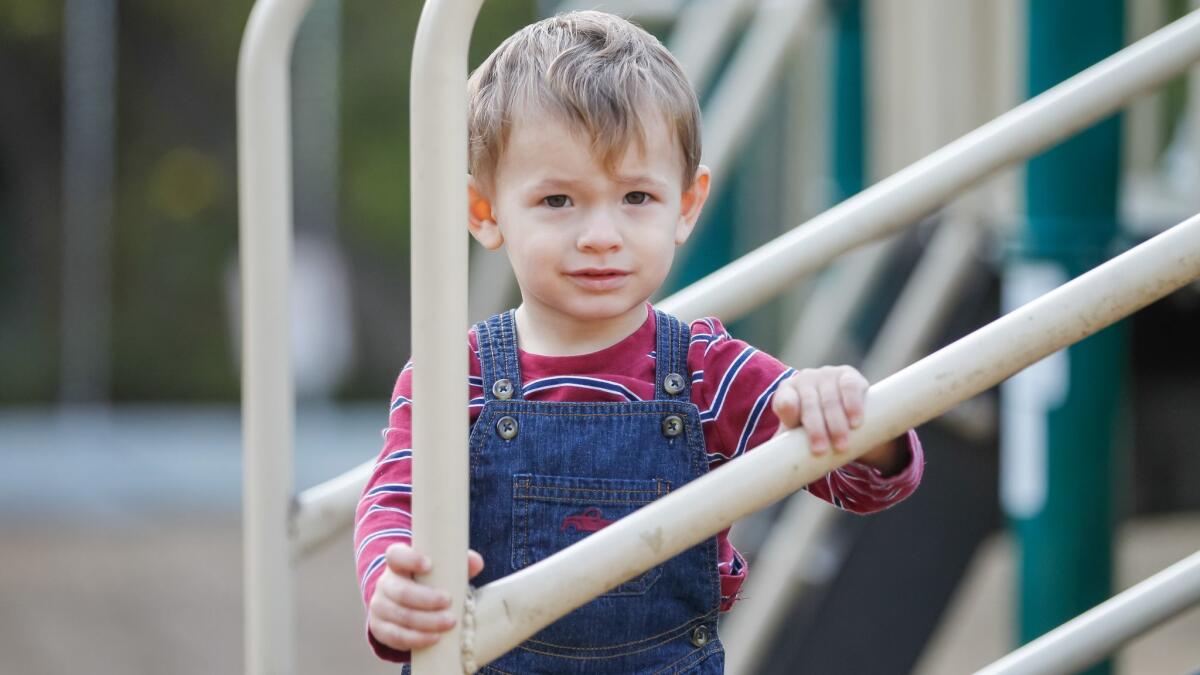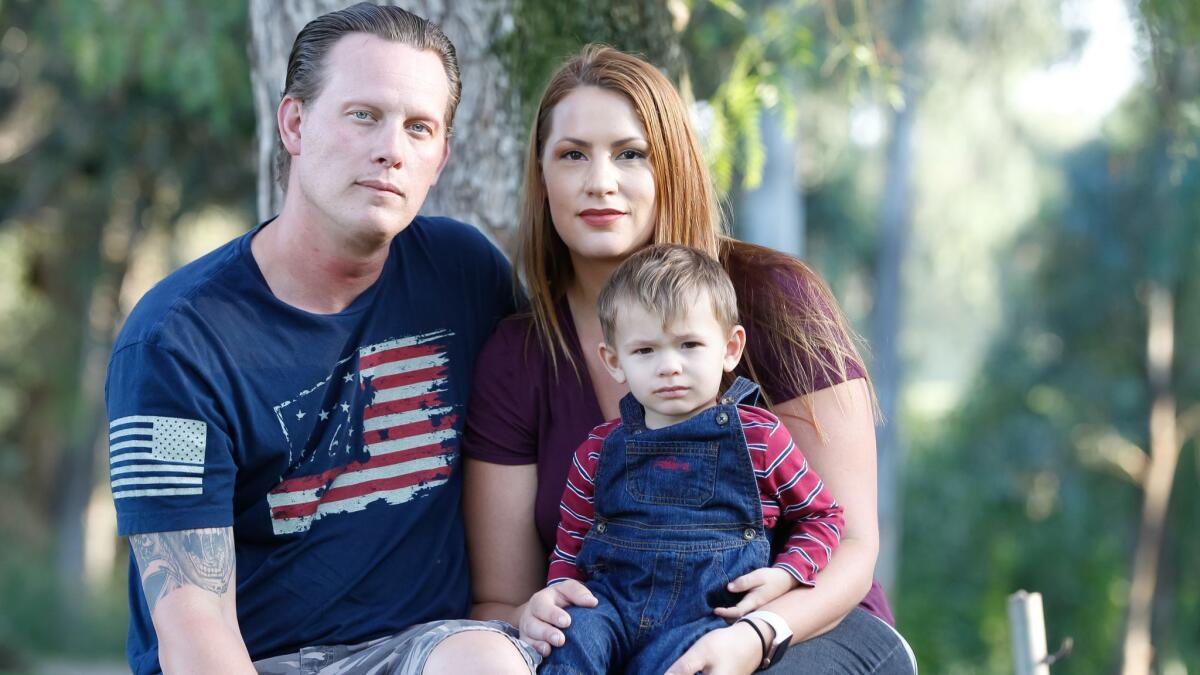Four children admitted to Rady Hospital in San Diego with rare wind-borne disease; more cases suspected

- Share via
Generally a blur of motion in his family’s Valley Center home, Jett Roper came to a sudden stop Oct. 11 with a 102-degree fever and full-body rash.
Within two days, the 21-month-old’s eyes were red-rimmed and bloodshot, and he was listless in a way his mother, Janalee Roper, had never seen before.
“If anyone touched him, it was ‘owie.’ He wouldn’t eat anything. He wouldn’t drink anything,” Roper said.
Three other families across San Diego County were dealing with the same symptoms at roughly the same time, all eventually getting admitted to Rady Children’s Hospital with the same rare diagnosis: Kawasaki disease.
Rady admitted the children in the five-day span from Oct. 9 through Oct. 14, and researchers believe the reason for the sudden cluster of cases was literally blowing in the wind.
No one knows for sure what causes Kawasaki, but researchers have long observed correlations between clusters of cases and changes in the weather. The working hypothesis is that disruptive weather patterns stir up something — maybe part of a virus or fungus or toxin — that launches an out-of-control immune response when it lands in the throats of genetically-susceptible people.
Normally, explained Dr. Jane Burns, director of the Kawasaki Disease Research Center at UC San Diego, October is not a big month for Kawasaki. Usually, the disease, first described by Japaneses researcher Tomisaku Kawasaki in 1967, hits hardest in March, with a second, smaller peak in early summer.

What was different about the time when this cluster of cases popped up?
Well, a big storm did drench the region with rain on Oct. 12 and 13. Burns, working with climate scientists, has authored several papers hypothesizing that it is something in the wind that “triggers” those who are genetically susceptible to Kawasaki disease, and she suspects that the weather in play right around the time of onset likely pulled that trigger.
“Clearly, our research is pointing towards an association between the large-scale environment, what’s going on with our climate on a large scale, and the occurrence of these clusters,” Burns said. “I don’t think it’s a coincidence that we had that funky storm and we saw this cluster of kids.”
Climate researcher Daniel Cayan of the Scripps Institution of Oceanography said that October rainstorm was born of an abnormal weather pattern that included a high-pressure atmospheric ridge over the ocean that created a low-pressure trough over Southern California.
That arrangement, he explained, created a counterclockwise wind rotation over San Diego County that started to ramp up on Oct. 7, causing breezes that moved in abnormal directions.
“It’s pretty clear that the winds and the direction of atmospheric transport were unusual for this time of year,” Cayan said.
He said there is not enough data to draw firm conclusions, but the correlation between a different weather pattern and a spike in Kawasaki disease cases is nonetheless intriguing.
“We’ve got more work to do in terms of understanding what happened, but it’s definitely interesting,” Cayan said.
In the meantime, Burns is focused on letting the community know that, if there were four, there may have been more. It’s possible that some kids who had the disease didn’t get diagnosed.
“These kids are sick enough that you don’t just stay home with them but, what happens is they get told ‘oh, it’s just a virus that’s going to last for a few more days and then it will go away,’” Burns said.
Many just move on once symptoms subside, the researcher said.
But eyes returning to their normal color, fevers breaking and rashes clearing do not mean a child is out of the woods.
When the immune system begins to attack healthy heart tissue, it can leave lasting damage that can be life-threatening. Over time, weak spots in blood vessels can cause a bulging area called an aneurysm that can allow a blood clot to slowly build. Later in life, maybe during childhood or often in early adulthood, that clot can break loose and cause a heart attack.
“We have young adults who walk in at age 30 with a massive heart attack, and they never knew there was anything wrong with their heart,” Burns said. “You go back in time, you talk to the parents, and you find out they had missed Kawasaki disease in childhood. The aneurysms are silent. There are no symptoms.”
But, if parents come in early, an aneurysm can be spotted with a painless sound-wave-based scan called an echocardiogram. If damage is detected, medications are available to keep clots from forming.
Given the cluster that has already been detected, Burns said parents should seek a deeper look from a doctor if their child recently had a fever of 101 degrees or greater and a rash absent the usual runny nose and other cold-like symptoms that are common with an elevated temperature.
Kawasaki only manifests in those who carry a rare set of genetic mutations. These changes are so rare that they usually are not present in siblings. So, another telltale sign of Kawasaki is symptoms that appear only in one child while everyone else in the family is unaffected.
Given the recent cluster of cases correlated so closely with out-of-the-ordinary wind patterns, Burns counseled parents to err on the side of caution.
“Fever, red eyes, and a rash — if it happened in this last week or so, it was Kawasaki disease until proven otherwise,” Burns said.
Another unambiguous sign is the skin on a child’s fingertips peeling. In about two-thirds of cases, this strange symptom appears about two weeks after other symptoms end, Burns said.
For some as-yet-unknown reason, Southern California and San Diego County in particular have a higher-than-average rate of Kawasaki cases. Most years, Rady treats between 80 and 100 Kawasaki patients, and the U.S. Centers for Disease Control and Prevention estimates that there are more than 5,000 cases every year nationwide.
Kawasaki is known to affect those of Asian descent at a greater rate than the general population. Asians living in San Diego County, Burns said, are two to three times more likely to have Kawasaki, but the four cases in the most recent cluster are quite diverse. One was Asian, one was Caucasian, one was African American and Caucasian and one was Latino.
Such a broad range only increases the researcher’s drive to solve the mystery of what’s blowing in the wind and triggering Kawasaki disease.
There is a suspicion, Burns said, that whatever the trigger is, it may have a similar protein pattern to those expressed in healthy cardiovascular tissue.
“We don’t know for sure that that’s what’s going on, it’s just somehow we have to explain [how] you breathe in something and then it attacks your heart,” Burns said.
For years, the Kawasaki center at UCSD has been collecting throat swabs from Kawasaki disease kids with the goal of finding those triggers. Today, the center is working with Imperial College in London to perform a full “microbiome” analysis of these San Diego samples with the goal of identifying every kind of foreign agent present in Kawasaki patients while they were sick. Once everything is catalogued, researchers hope they’ll be able to sort out the triggers by comparing large numbers of Kawasaki patients to those who had similar symptoms but didn’t have the disease.
The center is also working with UCSD microbiome wizard Rob Knight to analyze the microbes found under the fingernails of Kawasaki disease kids in the search for the disease trigger.
Burns has made this search her life’s work, and she said she is confident that recent advances in lab analysis will soon yield the secrets she has sought for decades.
“We’re absolutely going to figure this out before I die,” Burns said.
Sisson writes for the San Diego Union-Tribune.
More to Read
Sign up for Essential California
The most important California stories and recommendations in your inbox every morning.
You may occasionally receive promotional content from the Los Angeles Times.











